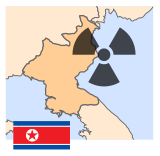2017 North Korean nuclear test
This article documents a current event. Information may change rapidly as the event progresses, and initial news reports may be unreliable. The latest updates to this article may not reflect the most current information. (September 2017) |
| 2017 North Korean nuclear test | |
|---|---|
 Graphic from the United States Geological Survey showing the location of seismic activity at the time of the test | |
| Information | |
| Country | North Korea |
| Test site | 41°20′35″N 129°02′10″E / 41.343°N 129.036°E[1] Punggye-ri Nuclear Test Site, Kilju County |
| Period | 12:00:01, 3 September 2017 UTC+08:30 (03:30:01 UTC)[1] |
| Number of tests | 1 |
| Max. yield |
|
| Test chronology | |
 |
|
North Korea conducted its sixth nuclear test on 3 September 2017, according to Japanese and South Korean officials. The Japanese Ministry of Foreign Affairs also concluded that North Korea conducted a nuclear test.[6] The United States Geological Survey reported an earthquake of 6.3-magnitude not far from North Korea's Punggye-ri nuclear test site.[7] South Korean authorities said the earthquake seemed to be artificial, consistent with a nuclear test.[6] The USGS, as well as China's earthquake administration, reported that the initial event was followed by a second, smaller, earthquake at the site, several minutes later, which was characterized as a collapse of the cavity.[8][9]
North Korea claimed that it successfully detonated a hydrogen bomb that can be loaded on to an intercontinental ballistic missile (ICBM) with great destructive power.[10]
Photos of North Korean leader Kim Jong-un inspecting a device which looked like a thermonuclear weapon warhead were released a few hours before the test.[11]
Yield estimates
According to estimates of Kim Young-Woo, the chief of the South Korean parliament's defense committee, the nuclear yield was equivalent to about 100 kilotons of TNT (100 kt). "The North's latest test is estimated to have a yield of up to 100 kilotons, though it is a provisional report," Kim Young-Woo told Yonhap News Agency.[2]
On 3 September, South Korea’s weather agency, the Korea Meteorological Administration, estimated that the nuclear blast yield of the presumed test was between 50 to 60 kilotons.[3]
In contrast, the independent seismic monitoring agency NORSAR estimated that the blast had a yield of about 120 kilotons.[4]
The Federal Institute for Geosciences and Natural Resources in Germany estimates a higher yield at "a few hundred kilotons" based on a detected tremor of 6.1 magnitude.[5]
Reactions
South Korea, China and Russia voiced strong criticism of the nuclear test.[12] US President Donald Trump tweeted "North Korea has conducted a major Nuclear Test. Their words and actions continue to be very hostile and dangerous to the United States".[13]
On September 3, U.S. Defense Secretary James Mattis warned North Korea, saying that the country would be met with a "massive military response" if it threatened the United States or its allies.[14]
US President Donald Trump was asked whether the US would attack North Korea and replied, "We'll see". [1]
United Nations Security Council will meet in an open emergency meeting on September 4th 2017 at the request of the US, South Korea, Japan, France and Great Britain. [2]
See also
References
- ^ a b "M 6.3 Explosion - 22km ENE of Sungjibaegam, North Korea". USGS. 3 September 2017. Archived from the original on 3 September 2017. Retrieved 3 September 2017.
{{cite web}}: Unknown parameter|deadurl=ignored (|url-status=suggested) (help) - ^ a b "N. Korea's apparent sixth nuke test estimated to have yield of 100 kilotons: lawmaker". Yonhap. 3 September 2017.
- ^ a b "North Korea nuclear test: what we know so far". Guardian. 3 September 2017.
- ^ a b "Large nuclear test in North Korea on 3 September 2017". NORSAR. 3 September 2017. Retrieved 3 September 2017.
- ^ a b "BGR registers a presumed nuclear test in North Korea". Germany BGR. 3 September 2017. Retrieved 3 September 2017.
- ^ a b "North Korea conducts another nuclear test, neighbors say". The Washington Post. 3 September 2017. Retrieved 3 September 2017.
- ^ "North Korea confirms sixth nuclear test". CNN. 3 September 2017. Retrieved 3 September 2017.
- ^ "North Korea claims successful hydrogen bomb test". Deutsche Welle. 3 September 2017. Retrieved 3 September 2017.
- ^ "North Korea nuclear test: 'Tunnel collapse' may provide clues". BBC News. 3 September 2017. Retrieved 3 September 2017.
- ^ "North Korea says it successfully tested hydrogen bomb, marking sixth nuclear test since 2006". ABC News. 3 September 2017. Retrieved 3 September 2017.
- ^ "Kim inspects 'nuclear warhead': A picture decoded". BBC News. 3 September 2017. Retrieved 3 September 2017.
- ^ "North Korea nuclear test: Trump condemns 'hostile' move". BBC News. 3 September 2017. Retrieved 3 September 2017.
- ^ Donald J. Trump [@realDonaldTrump] (3 September 2017). "North Korea has conducted a major Nuclear Test. Their words and actions continue to be very hostile and dangerous to the United States..." (Tweet) – via Twitter.
- ^ "Mattis warns North Korea of 'massive military response' if it threatens US". The Hill. 3 September 2017. Retrieved 3 September 2017.
